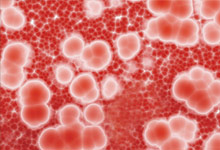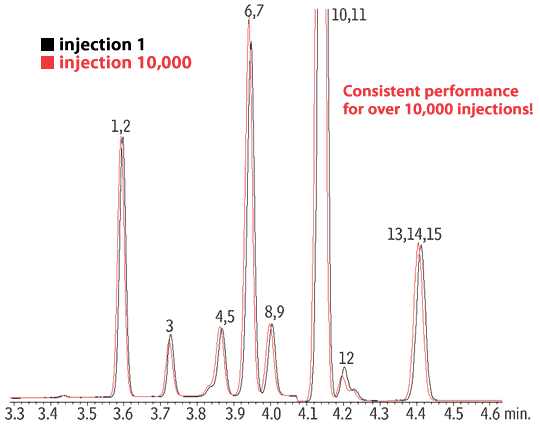01494 563377
Reduce Downtime with Robust Lipidomics Method
By Julie Kowalski, Ph.D., Innovations Chemist, and John Hanley Jr., Ph.D.*, Platform Development Manager
*Lipomics Technologies
Why lose days to downtime? Restek columns, such as the 10,000 injection Rxi®-5ms column shown here, are rugged and built for consistent long-term performance.
Lipidomic studies of cholesterol synthesis, absorption, and excretion, provide information central to the investigation of cardiovascular disease and other disorders. High-throughput methods are critical to lipidomics and are used to screen thousands of samples in order to identify biomarkers and clinical diagnostics with significant predictive power. Labs can save days of downtime by using an Rxi®-5ms column in assays similar to our test method for cholesterol and low-level sterol metabolites.
Reduced downtime for column changes and revalidation lead to significantly increased lab productivity.
Here, extremely reproducible results were obtained using an Rxi®-5ms column, which gave highly consistent separations—even after 10,000 injections (Figure 1). In our method, biological samples were treated to form trimethylsilyl derivatives. Two injections were made: one to quantify minor sterols using a 10:1 split, and another, using a 100:1 split, to analyze cholesterol. To achieve maximum sensitivity for low-level sterols, multiple SIM retention time windows were set up.
Stable retention times are critical to our testing program as revalidation is required if significant drift occurs. Revalidation requires days of downtime because inter-day variability must be assessed. The Rxi®-5ms column was chosen for this method, in part, because its long lifetime and stable performance reduced the number of column changes and revalidations, resulting in more days of productive analyses.
We found the performance of the Rxi®-5ms column to be remarkably consistent and reliable for high-throughput testing. The Rxi®-5ms column should be considered by labs running similar lipidomic methods that would benefit from a highly reproducible performance—or by any lab interested in reducing downtime and increasing productivity.
| Figure 1: Stable, highly reproducible results on the Rxi®-5ms column mean less downtime and more productive days. | |||||||||||||||||||||||||||||||||||||||||||||||||||||||||||||||||||
|---|---|---|---|---|---|---|---|---|---|---|---|---|---|---|---|---|---|---|---|---|---|---|---|---|---|---|---|---|---|---|---|---|---|---|---|---|---|---|---|---|---|---|---|---|---|---|---|---|---|---|---|---|---|---|---|---|---|---|---|---|---|---|---|---|---|---|---|

GC_PH01053
|

